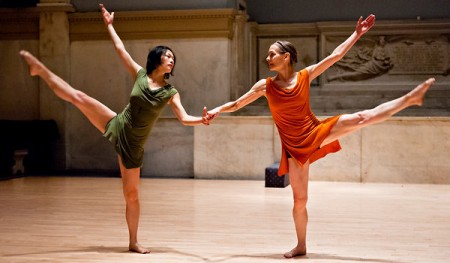But the choreographer has her madcap and her romantic sides as well. Both of these were on display Monday night at the Judson Memorial Church, when Molissa Fenley and Company presented an economical 50-minute program of two New York premieres.
First came “Credo in Us” (2011), a structural experiment in high silliness made in response to the John Cage composition — a percussive feast written in 1942 — from which the dance takes its name. Ms. Fenley and six other women zipped through a prop-laden gamut, with the choreographer generating material partly in response to her company members’ impressions of the music prior to the performance.
Pots as helmets, orange hazard cones, bowls and plates: the objects keep coming. So do the movement formations, as the choreography converses with the many tones — jazzy, industrial, playful — in Cage’s score. (Khadda Madani’s costumes, short dresses with a hint of colorful patchwork trains, echo this idea of collage.)
The result is a series of semiabstract dance-theater skits, bleeding one into the next so that the surface of the work becomes all but illegible at times. It is a tactic both maddening and delightful.
At its most poetic moments, “Credo in Us” evokes the layered, splintered feel of Sappho verse fragments whirring through time and space. When the dancers paused in a tableau, with Ms. Fenley cast onto her back before women bearing a silver fabric banner, you could imagine an epic, mercurial battle. Ms. Fenley’s honed, angled movement palette tends to lend itself to martial metaphors, in any case, and her cuneiform shapes to remind of classical forms.
At other times, the manic business just feels like manic business. And some of the props, like a frying pan with plastic breakfast foods stuck inside it, are too particular to seem anything other than distractingly jokey.
“The Vessel Stories” (2011) is another creature entirely. A dance quartet set to Philip Glass’s marvelously moody “String Quartet No. 4 (Buczak),” the nonrepresentational work is replete with lyrical threads.
Perhaps these four women, dressed in simple, clingy tunics (by Jill St. Coeur) were statuary come to life. I kept seeing a garden party at night, under a windy, star-swept sky. But Judson’s Romanesque architecture, warmly lighted by David Moodey, is a fine container for Ms. Fenley’s ceaseless, stylized movement eddies, which conjure courtly dances by slightly wild-minded muses.
The heart of the dance is an extended middle section, the dreamy “100 Vessels,” danced by Ms. Fenley and Peiling Kao. Here, the choreographer’s bladelike intensity stands in sharp relief against the younger performer’s softer attack.
The stories here are wordless ones. The women skitter through the space in quick traveling hops that seem both deft and heroic. They gather up the space with curving arms before plunging into it. As watchers, we can follow or drift in our own streams; there is always something good to return to.




